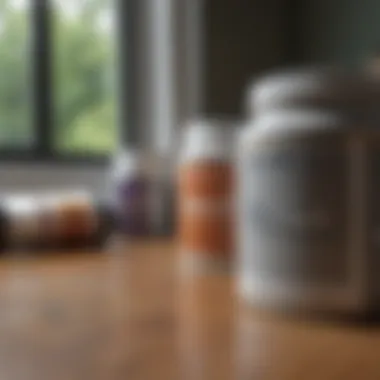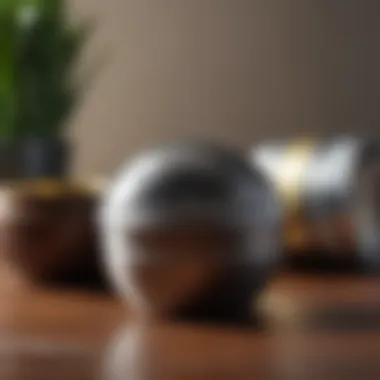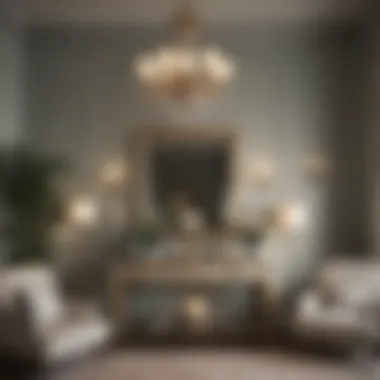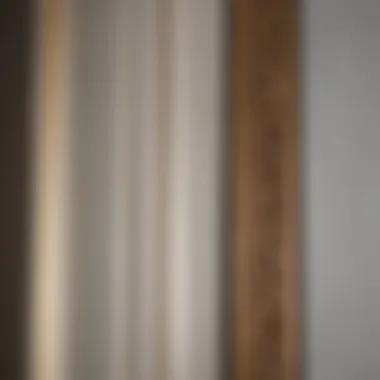Choosing the Right Paint Sheen for Trim


Intro
Selecting the right paint sheen for trim is an essential decision for any homeowner or interior designer. The sheen not only influences the aesthetic of a space but also contributes to the trim’s durability and maintenance. Different levels of shine can dramatically change the perception of a room.
High-gloss finishes enhance architectural details, while flat or matte finishes can soften a look. The choice of sheen plays a significant role in overall design coherence. Understanding the implications of each paint sheen can help in achieving desired results and maintaining the integrity of painted surfaces over time.
The importance of this topic cannot be understated; as many renovations or new constructions involve substantial investments, ensuring the right choice of trim paint is crucial. Whether you are planning for a dining room or a retail space, this guide will equip you with knowledge to make informed decisions that elevate the space.
Design Inspiration
Trending Styles
As trends in interior design evolve, so too do the styles associated with paint sheen. Currently, there is a shift towards semi-gloss and satin finishes for trim in residential spaces. These finishes provide a balance between shine and versatility, making them suitable for both modern and traditional designs. Such styles emphasize clean lines and a polished appearance that can elevate the overall aesthetic of the home.
Commercial spaces, on the other hand, often favor high-gloss finishes for accent trim. This choice not only aids in durability but also reflects light, creating an open and spacious feel.
Color Palettes
Choosing the right color palette to complement your trim is equally important. Soft whites and creamy neutrals continue to dominate the color schemes, offering a timeless appeal. However, bold colors are also gaining traction, especially in settings that encourage creativity, such as art studios or cafes. When selecting a color, it is essential to consider how it interacts with the chosen sheen. A glossy finish on a rich, deep hue can provide an eye-catching contrast that highlights architectural features.
Practical Tips
Maintenance & Care
Once the trim is painted, maintaining it becomes crucial. High-gloss and semi-gloss finishes are more resilient to cleaning, making them ideal for high-traffic areas. Regular dusting and the occasional wipe with a damp cloth can keep the sheen looking fresh. On the other hand, matte finishes may require more delicate handling, as they can be prone to scuffs and stains. It may be beneficial to schedule periodic touch-ups to maintain their integrity.
Budgeting & Planning
Budget considerations also play a role in sheen selection. Generally, higher-gloss paints tend to be more expensive due to their durable properties. Additionally, proper preparation of the surface prior to painting may incur extra costs but ultimately affects the longevity and appearance of the final coat. Planning ahead for these extras can save time and reduce stress later in the project.
"The sheen of paint can make or break the overall look of your space. It's not just about color, but texture and reflectivity too."
Understanding Paint Sheens
In the realm of interior design, the selection of paint sheen for trim is a critical aspect that warrants a thoughtful approach. Understanding paint sheens involves grasping how different levels of shine not only influence aesthetics but also affect durability and maintenance over time. This comprehension allows homeowners and designers to make informed choices that enhance both the visual impact of a space and its long-term upkeep.
Definition of Paint Sheen
Paint sheen refers to the level of glossiness exhibited by a paint finish once it dries. It is categorized into several types, varying from flat or matte to high-gloss. This spectrum defines how much light the surface reflects.
- Matte Sheen: Offers no shine, absorbing light effectively, which creates a soft, velvety appearance.
- Eggshell Sheen: Slightly more lustrous than matte, resembling the surface of an eggshell.
- Satin Sheen: Reflects a good amount of light, providing a smooth surface that is both attractive and durable.
- Semi-Gloss Sheen: Provides a higher shine, making it suitable for areas needing durability.
- High-Gloss Sheen: Maximum reflectivity, ideal for dramatic effects and easy cleaning.
Understanding these definitions helps in conceptualizing how each sheen can be utilized in different settings and enhances the overall design intent.
Importance of Sheen in Interior Design
The selection of the right paint sheen goes beyond mere preference; it plays a pivotal role in the design scheme of any space. It can shape atmospheres, guide maintenance demands, and even affect perceived dimensions of spaces. For instance, high-gloss finishes can make a small room seem larger due to their reflective properties, while matte finishes may add warmth and coziness.
Moreover, different sheens can enhance or detract from architectural details. Well-chosen finishes can highlight the contours of trim, molding, or other design elements, enriching the overall narrative of the interior.


In terms of practicality, the sheen affects durability. High-gloss and semi-gloss paints are more resistant to wear and are easier to clean, making them suitable for high-traffic areas or spaces prone to stains, such as kitchens and bathrooms.
Choosing the right paint sheen is not merely an aesthetic decision; it involves considering functionality, maintenance, and desired ambiance.
Types of Paint Sheen
Understanding the types of paint sheen is vital for achieving the desired aesthetic and functional outcome in any trim painting project. Each sheen type can significantly affect the appearance of the painted surface, its durability, and how it maintains its look over time. Selecting the right sheen not only enhances the beauty of the trim but also contributes to the overall harmony of a space.
Matte Sheen
Matte sheen, often referred to as flat paint, has no shine and is valued for its ability to hide imperfections. This type offers a smooth finish that absorbs light rather than reflecting it. Matte sheen is commonly used on walls and ceilings but can also be considered for trim, particularly in low-traffic areas. Due to its lack of gloss, it is less resistant to stains and dirt, making it difficult to clean. Therefore, while it can provide a soft, understated look, its practicalities require careful consideration, especially in spaces prone to smudging or wear.
Eggshell Sheen
Eggshell sheen sits between matte and satin, providing a slight sheen without being overly glossy. This makes it a popular choice for trim. The low luster of eggshell offers a balance between aesthetics and functionality. It reflects some light, which can help enhance the trim's features, while still being relatively easy to clean. Eggshell is suitable for residential settings, particularly in areas like living rooms and dining rooms, where a touch of elegance is desired without high maintenance demands.
Satin Sheen
Satin sheen has a soft sheen that strikes a happy medium between eggshell and semi-gloss. This finish is durable and easy to clean, making it appropriate for high-traffic areas such as hallways and kitchens. The satin finish allows for light reflection, which can enrich the color of the paint. It also enhances the architectural details of the trim, accentuating its shape and lines. If durability is a key consideration, satin sheen is often recommended, as it withstands wear and tear better than flatter finishes.
Semi-Gloss Sheen
Semi-gloss sheen provides a noticeable shine, making it an ideal choice for areas that require durability and ease of cleaning, such as kitchens and bathrooms. It reflects more light than satin, adding a crisp, finished look to trim. This sheen type is also highly resistant to moisture and stains. However, semi-gloss can highlight imperfections, so surface preparation is crucial to achieve a clean look. Trim painted in semi-gloss finishes stand out and can add a touch of sophistication to any room, enhancing both modern and traditional designs.
High-Gloss Sheen
High-gloss sheen is the most reflective option available. This finish is strikingly shiny and is often used for accent pieces or to create a bold statement with trim. High-gloss offers excellent durability, making it suitable for areas prone to heavy use. It can withstand cleaning and is good for high-moisture environments. However, due to its reflective nature, this sheen can expose imperfections on the surface. Choosing high-gloss requires careful surface preparation and consideration of the overall design scheme. For those looking to make a dramatic impact, high-gloss trim can undoubtedly draw attention and elevate the aesthetic appeal of any space.
Factors Influencing Sheen Selection
Choosing the right sheen for trim depends on several factors that directly impact aesthetics and functionality. These factors include the space's intended use, lighting conditions, the material of the trim, and individual aesthetic preferences. Understanding these influences is essential for making informed decisions.
Functionality of the Space
The purpose of a room plays a crucial role in selecting the appropriate paint sheen. For instance, high-traffic areas such as hallways may necessitate more durable finishes, such as semi-gloss or satin, which are easier to clean and resist scuff marks. In contrast, a bedroom or formal dining room may benefit from a matte sheen, providing a softer look that feels more inviting.
Considering whether the space is utilized for relaxing, entertaining, or working can guide the choice of sheen. For example, if a space is frequently used for family gatherings or social events, a finish that withstands wear and tear while maintaining an attractive appearance is recommended.
Lighting Conditions
Lighting can greatly affect how paint sheen appears. Natural and artificial light can influence the perception of color and shine. In well-lit rooms, a high-gloss finish can reflect too much light, creating glare and overpowering the aesthetic. Conversely, matte or eggshell finishes can help absorb light, softening the overall look.
In áreas with limited light, a satin or semi-gloss sheen adds dimension and brightness, helping to open up the space visually. Evaluating both the type and amount of light in a room is vital to achieving the desired effect with paint sheen.
Trim Material
The material of the trim itself can influence sheen selection. Wood trim can be painted in various sheens, but paint may behave differently on different finishes. For example, a high-gloss finish may highlight imperfections in the wood, whereas a satin finish may better conceal them. On the other hand, trim made from synthetic materials, such as PVC, often benefits from a gloss finish, which enhances durability and allows for easier cleaning.
Understanding how the paint interacts with the trim material helps in choosing a sheen that complements both appearance and performance.
Aesthetic Preferences


When it comes to paint sheen, personal style plays a significant role. A homeowner’s aesthetic preference heavily influences the choice of sheen. Some individuals may prefer the elegance of high-gloss finishes that create a polished look, while others may gravitate towards the understated charm of matte finishes.
It is also essential to consider how the chosen sheen fits within the broader color scheme and style of the space. For example, a modern, minimalist design might benefit from a sleek, reflective sheen, while a traditional or rustic environment may find solace in the warmth of a matte finish.
"Selecting paint sheen is not merely a technical decision; it is also a personal expression of style and function."
In summary, factors such as the functionality of the space, lighting conditions, trim material, and aesthetic preferences all play integral roles in choosing the right paint sheen. Each consideration complements the others, leading to a more thoughtful and informed selection process.
Implications of Different Sheens
Understanding the implications of various paint sheens is crucial in the selection process for trim. Different sheens carry unique properties that affect the overall performance and aesthetic outcomes of painted surfaces. It is not merely about choosing a color; it involves meticulous consideration of how each sheen level impacts visual appeal, durability, and maintenance requirements.
Impact on Visual Appeal
The sheen of paint significantly influences how a surface reflects light, which in turn affects the visual perception of a space. Higher sheens like semi-gloss and high-gloss reflect more light, often creating an illusion of depth and brightness. This can be particularly effective in smaller rooms, where enhanced light reflection can make the area feel larger and more open.
Conversely, lower sheen options such as matte or eggshell have a softer appearance, absorbing light rather than reflecting it. This quality can lend itself to a more subdued and elegant atmosphere, but it might not show trim details as vividly. It’s important to decide based on how you want the space to feel and how elements within it complement each other.
An example: if your trim is intricately designed, a semi-gloss or glossy finish can highlight its details, whereas a matte finish might obscure some of those fine points.
Discussion on Durability
Durability is another vital aspect that needs attention when choosing a paint sheen for trim. High-gloss and semi-gloss finishes are often more durable and resistant to wear and tear compared to their matte counterparts. This resilience makes them especially suitable for high-traffic areas or spaces prone to moisture, such as kitchens and bathrooms.
When considering durability, think about the environment where the trim will exist. For instance, a high-gloss finish in a bathroom can withstand steam and humidity better than a matte finish, which might deteriorate over time. This makes it essential to understand the specific use case for your trim and select a sheen that will endure its surroundings.
Maintenance Considerations
Maintenance is an often-overlooked element when selecting paint sheen. Some finishes are inherently easier to clean than others. For instance, semi-gloss and high-gloss paints can be wiped down without much struggle, making them ideal for areas that may get dirty or scuffed. In contrast, a matte finish may require more careful handling, with certain stains potentially being more challenging to remove.
When considering maintenance, it is also useful to think about the longevity of the finish. Higher sheen options tend to hide imperfections better; however, they can also show every smudge and fingerprint, necessitating more frequent cleaning. On the other hand, while a lower sheen may not require as much cleaning, it could demand repainting sooner due to its susceptibility to scuffs and damage.
To summarize:
- Visual Appeal: Light reflection influences perception of space.
- Durability: Higher sheens resist wear and moisture better.
- Maintenance: Gloss finishes offer easier cleaning; matte may need replacing sooner.
Best Practices in Trim Painting
When it comes to painting trim, following best practices can make a significant difference in the overall look and durability of the finished product. Trim often serves as the finishing touch in a room, providing contrast and definition. Hence, the right techniques and approaches are crucial not only for aesthetics but also for longevity. By considering specific elements and benefits of these practices, homeowners and designers can ensure a high-quality outcome.
Preparation Techniques
Preparing the trim before painting is essential. This stage sets the foundation for a smooth application and lasting finish. Areas that are not ready may lead to uneven surfaces and compromised durability. Here are some preparation techniques that can be employed:
- Cleaning: Start by cleaning the trim thoroughly to remove dust, dirt, and grease. A simple wipe down with a damp cloth often suffices. If needed, a mild detergent can be used, but ensure the surface dries completely afterwards.
- Sanding: Lightly sand the trim to create a surface that the paint can adhere to better. This step is particularly effective on glossy surfaces which can be difficult for paint to cling to.
- Filling Gaps: Inspect the trim for any gaps or holes. Using wood filler or caulk can help achieve a seamless look. Once the filler dries, sand it down to ensure it is flush with the trim surface.
These practices not only improve the adhesion of paint but also contribute to a professional-looking finish.
Application Methods
Applying the paint correctly can greatly influence the sheen and end result. Choosing the right application method depends on the type of paint and the desired finish. Here are key methods to consider:


- Brushing: A high-quality angled brush allows for precision in corners and detailed areas of trim. Brushing is typically recommended for semi-gloss and high-gloss finishes to achieve a smooth application.
- Rolling: For larger trim areas, a small roller can be efficient. It can provide an even coat with fewer strokes, minimizing the risk of brush marks. This method tends to benefit satin and eggshell finishes.
- Spraying: For very smooth and even coats, consider using a paint sprayer. While this method requires more preparation and masking, it can cut down on application time and provide a flawless finish, especially for high-gloss sheens.
Whichever method you choose, proper technique and consistent strokes will enhance the final appearance of the trim.
Choosing Quality Products
Selecting the right supplies, particularly paint and tools, is paramount. Quality can vary significantly between products, impacting the final outcome. Consider the following aspects when choosing:
- Paint Type: Aim for paints with good durability and washability. Brands like Benjamin Moore and Sherwin-Williams often receive high marks in these categories.
- Finish: Select appropriate sheen for your specific needs. Semi-gloss and satin finishes are popular for trim due to their balance of durability and aesthetics.
- Tools: Invest in quality brushes and rollers. High-density foam rollers can minimize texture while good brushes can reduce streaks.
Quality products can lead to superior results, making the initial investment worthwhile.
Important Note: Proper preparation, effective application methods, and choosing quality products are essential best practices that will significantly enhance your trim painting project.
The right practices in trim painting ensure that the finished work not only looks good but will stand the test of time.
Common Mistakes to Avoid
Over-Estimating Sheen's Role
Many people believe that the sheen of paint is the singular factor in achieving a desired look. While sheen plays a significant role, it is not the only consideration. Over-estimating its impact can lead to disappointment once the project is complete. For instance, a high-gloss finish might seem appealing in theory due to its shine, but in reality, it can highlight imperfections in the trim and surrounding surfaces. On the other hand, a matte sheen may provide a warm feel but lacks the durability needed for high-traffic areas.
When selecting the sheen, one must consider the paint quality, color, and application method in addition to sheen level. A holistic approach ensures that all elements harmonize to create the desired aesthetic.
Here are several key aspects to keep in mind:
- Balance: Achieving the right balance between aesthetic and functionality is crucial.
- Compatibility: Ensure that the sheen complements other finishes within the space.
- Expectations: Adjust expectations according to how light interacts with different sheens.
Neglecting Environment-Specific Needs
Another mistake is neglecting the specific requirements of a given environment when selecting paint sheen. Different spaces and their uses dictate the durability and maintenance of the trim. For instance, in a kitchen or bathroom where moisture levels are high, a semi-gloss or high-gloss finish may be more appropriate, as these sheens repel moisture and are easier to clean. Conversely, in less demanding environments, an eggshell or satin sheen may suffice, offering a soft look without the demands of gloss finishes.
Environmental elements such as natural light, humidity, and even foot traffic should be at the forefront of the decision-making process. Taking these factors into consideration can help avoid issues that arise from poor sheen choices.
- Light Sources: Natural and artificial lighting can alter the appearance of the sheen.
- Usage Patterns: Assess how the area will be used over time to choose a finish that withstands expected wear and tear.
- Climate: In areas with high humidity, opt for paints designed to handle such conditions.
Overall, being aware of these common mistakes and understanding the implications of paint sheen selection can lead to more satisfying results. Careful consideration ensures that the chosen paint will meet both aesthetic and functional requirements.
Culmination and Recommendations
In concluding this exploration of selecting the right paint sheen for trim, it becomes evident that the correct choice significantly influences both aesthetic and practical outcomes. Understanding paint sheen is not merely a matter of personal taste; it is essential for achieving desired effects in various spaces, whether residential or commercial.
The recommendations offered through this article aim to synthesize the detailed analysis presented. Homeowners and interior designers should consider the unique characteristics of each sheen type in relation to the specific environment of application. Knowing that factors such as lighting conditions, trim material, and functionality of the space all play a critical role is vital for an informed decision. Moreover, opting for quality products, preparing surfaces adequately, and employing proper application methods ensure durability and beauty.
It is also invaluable to remember that paint sheen should not be overstated or neglected. Achieving a desirable final result depends on a thoughtful balance between functionality and aesthetic appeal.
"The right paint sheen enhances not just the look, but also the longevity of the surfaces in our environments."
By adhering to these principles, one can avoid common pitfalls and maximize the positive impact of paint sheens in interior design. A well-informed choice brings satisfaction and practicality to spaces that receive frequent use.
Summary of Insights
Throughout this article, we delved into specific elements that contribute to making a well-rounded decision about paint sheens. Understanding the various types of sheens such as matte, eggshell, satin, semi-gloss, and high-gloss sheds light on how each contributes uniquely to trim presentations. Furthermore, we explored factors that influence the sheen selection, emphasizing the functional context of the application. The implications of sheen choices were also discussed, shedding light on their impact on visual appeal, durability, and maintenance practices.
Final Recommendations By Sheen
- Matte Sheen: Best suited for low-traffic areas. Good for minimizing imperfections but may require touch-ups over time.
- Eggshell Sheen: Ideal for spaces where a slight luster is desired but high durability is not critical. A good compromise for formal areas.
- Satin Sheen: Versatile. Good for moderate traffic areas like hallways or living rooms. Easy to clean without being too glossy.
- Semi-Gloss Sheen: Highly recommended for trims and moldings. It withstands wear and is easy to clean. Provides a sleek finish that defines features well.
- High-Gloss Sheen: Best for high-impact areas or where a sleek, polished look is desired. Excellent for durability, though reflects more light.
Each choice affects how spaces are perceived and can enhance or detract from the overall interior design. This comprehensive guidance intends to aid in navigating the critical decision of paint sheen for trim, ensuring that both appearance and performance are adequately addressed.















